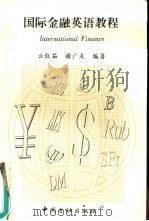《货币政策与理论 英文版》
| 作者 | 米尔顿·H·马奎斯(Milton H. Marquis)著 编者 |
|---|---|
| 出版 | 沈阳:东北财经大学出版社 |
| 参考页数 | 389 |
| 出版时间 | 1998(求助前请核对) 目录预览 |
| ISBN号 | 781044204X — 求助条款 |
| PDF编号 | 87012568(仅供预览,未存储实际文件) |
| 求助格式 | 扫描PDF(若分多册发行,每次仅能受理1册) |

PART 1 FUNDAMENTALS OF MONETARY THEORY1
1 CURRENCY IN AN ISLAND ECONOMY2
1.1 Money and Barter2
1.2 Method of Analysis3
1.3 An Island Economy5
1.4 Autarky7
1.5 Barter under Bilateral Exchange with No Intermediate Trades8
1.6 Barter under Bilateral Exchange with Intermediate Trades12
1.7 Exchange with Commodity Money13
1.8 Exchange with Representative Commodity Money17
1.9 Exchange with Fiat Money19
1.10 Summary20
2 THE MONIES OF A MODERN ECONOMY25
2.1 The Monetary Aggregates26
2.2 Ml26
2.3 M231
2.4 M3 and L37
2.5 Units of Money39
2.6 Credit Card Transactions and Money40
2.7 Summary40
3 THE DEMAND FOR MONEY45
3.1 A Household's Transactions Demand for Money46
3.2 A Household's Precautionary Demand for Money49
3.3 The Demand for Money by Firms49
3.4 An Aggregate Money Demand Function50
3.5 Estimating the Demand fOr Money52
3.6 The Demand fOr Real Money Balances54
3.7 Velocity54
3.8 Secular Changes in the Demand for M156
3.9 The Velocity of M259
3.10 Other Velocity Measures62
3.11 Summary65
4 STOCK AND BOND VALUUAION AND THE TERM STRUCTURE OF INTEREST RATES70
4.1 Household Preferences and the Required Return to Savings71
4.2 The Fisher Equation74
4.3 Bond Valuation75
4.4 Stock Valuation77
4.5 Bond Stock and Price Fluctuation79
4.6 The Term Structure of Interest Rates: The Pure Expectations Hypothesis80
4.7 The Yield Curve82
4.8 The Liquidity Premium83
4.9 Interpreting the Slope of the Yield Curve85
4.10 Summary86
PART II FUNDAMENTALS OF MONETARY AND FINANClAL INSTITUTIONS89
5 FiNANCIAL INTERMEDiATION90
5.1 Financial Intermediation in an Island Economy91
5.2 FinancialIntermediation and the Matching of Intertemporal Preferences91
5.3 Risk Assessment, Agency Costs, and Uncertain Investment Projects95
5.4 Financial Intermediation and Risk-Reduction through Diversification98
5.5 Financial Intermediation and Delegated Monitoring99
5.6 Summary101
6 FINANCIAL INSTITUTIONS105
6.1 Financial Intermediation in Stocks and Bonds106
6.2 The Financial Intermediation of Depository Institutions108
6.3 Mutual versus Stock-Based Ownership of Depository Institutions111
6.4 Depository Institutions in the United States112
6.5 A Closer Look at Commercial Banking112
7 THE MONEY SUPPLY PROCESS113
6.6 Loan Default Risk, Deposit Insurance, and Capital Requirements118
6.7 Summary120
7.1 Reserve Aggregates124
7.2 The Federal Reserve's Balance Sheet127
7.3 Open Market Operations129
7.4 The Relationship betWeen Open Market Operations and Total Bank Reserves131
7.5 Multiple Deposit Creation: A Simple Example133
7.6 Reserve Aggregate Multipliers136
7.7 Money Multipliers137
7.8 The Sources of Imperfect Monetary Control139
7.9 Endogenous Money Supply140
7.10 Summary140
8 INSTITUTIONS OF MONETARY CONTROL: HISTORICAL ROLE OF THE FEDERAL RESERVE IN THE UNITED STATES144
8.1 The Problem of an Inelastic Money Supply145
8.2 Endogenous Money Supply147
8.3 Unintended Consequences of Open Market Operations, 1917-1921149
8.4 The Centralization of Monetary Policy Decision Making, 1921-1935151
8.5 The Gold Purchase Program and Treasury Department Dominance, 1933--1937155
8.6 Unintended Consequences of Reserve Requirement Changes,1937-1938157
8.7 World War II and the U.S. Government Bond Price Support Program, 1939-1945158
8.8 The Treasury--Federal Reserve Accord: Truce and Settlement, 1945-1952159
8.9 The Collapse of the Bretton Woods Agreements, 1952--1973160
8.10 Post-Bretton Woods and the Humphrey-Hawkins Full-Employment Act162
8.11 Summary164
PART III EQUILIBRIUM ANALYSIS169
9 "FULL ENPLOYNENT" AND MONETARY POLICY NEUTRALITY170
9.1 Modeling the Economy as a Collection of Aggregate Markets171
9.2 The Principal Economic Agents and Their Roles in Determining Equilibrium172
9.3 Household Preferences174
9.4 The Consumption/Savings Decision177
9.5 The Portfolio Allocation Decision178
9.6 The Labor/Leisure Decision180
9.7 Technology of the Goods-Producing Firms182
9.8 The Production and Labor Demand Decision184
9.9 The Investment and Bond Supply Decision185
9.10 The Government's Money Supply Decision188
9.11 General Equilibrium189
9.12 "Full Employment"192
9.13 Monetary Policy Neutrality193
9. 14 Summary196
10 ECONOMIC FLUCTUATIONS AND MONETARY ACCOMMODATION199
10.1 Total Factor Productivity Shocks201
10.2 The Response of Firms to a Positive Productivity Shock203
10.3 The Response of Households to a Positive Productivity Shock204
10.4 The Determination of Nominal Wages205
10.5 Equilibrium Analysis of a Positive Productivity Shock without Monetary Accommodation206
10.6 Equilibrium Analysis of a Positive Productivity Shock with Monetary Accommodation207
10.7 Preference Shocks210
10.8 Intratemporal Preference Shocks211
10.9 Intertemporal Preference Shocks213
10.10 Summary216
11 STABILIZATION POLICY WHEN FIRMS SET PRICES IN ADVANCE219
11.1 Price Setting by Firms220
11.2 Liquidity-Constrained HousehOlds222
11.3 Equilibrium Response without Monetary Accommodation in the Absence of Preference Shocks224
11.4 Equilibrium Response with Monetary Accommodation in the Absence of Preference Shocks227
11.5 Monetary Policy and the Signal Extraction Problem229
11.6 Equilibrium Response with Monetary Accommodation in the Presence of an Intratemporal Preference Shock230
11.7 Equilibrium Response with Monetary Accommodation in the Presence of an Intertemporal Preference Shock236
11.8 Summary239
12 STABILIZATION POLICY IN THE PRESENCE OF LONGTERM NOMINAL WAGE CONTRACTS244
12.1 A Keynesian Labor Market246
12.2 Response of the Economy to a Productivity Shock When Nominal Wages Are Set in Advance and When There Is No Attempt at Monetary Accommodation248
12.3 Response of the Economy to a Positive Shock When Nominal Wages Are Set in Advance and There Is an Attempt at Monetary Accommodation251
12.4 Is the Full-Employment Objective of Stabilization Policy Inappropriate When Preference Shocks Are Long-lived?256
12.5 Response of the Economy to a Long-Lived Intratemporal Preference Shock When Nominal Wages Are Set in Advance257
12.6 Response of the Economy to a Long-Lived Intertemporal Preference Shock When Nominal Wages Are Set in Advance265
12.7 Summary270
PART IV DESCRIPTlVE DYN MICS AND INFLATION275
13 A CRITIQUE OF STABILIZATION POLICY276
13.1 A Monetarist Critique of Stabilization Policy277
13.2 Time Lags and Macroeconomic Dynamics279
13.3 Recognition Lag280
13.4 Policy Design and Implementation Lags281
13.5 The Dynamic Response of the Economy to a Change in Monetary Policy282
13.6 Sluggish Prices283
13.7 Long and Variable Lags285
13.8 Stabilization Policy in Practice289
13.9 Summary291
14 MONETARY RULES294
14.1 Long-Run PoliCy Objectives294
14.2 Policy Design: The Constant Growth Rate (CGR) Rule297
14.3 Long-Run Structural Changes and the CGR Rule300
14.4 Financial Instability and the CGR Rule301
14.5 Long-Run Consequences of an Active Stabilization Policy303
14.6 Summary306
15 INFWION AND SEIGNIORAGE: WHAT IS OPTIMAL?310
15.1 Inflation Taxes in the Island Economy310
15.2 Price Level Stability313
15.3 Labor Market Rigidities and Moderate Inflation315
15.4 Seigniorage316
15.5 Summary319
PART V THE MECHANICS OF POLICY AND POLICY-MAKING323
16 OPTIMAL TARGETING AND THE RESPONSE OF FINANCIAL MARKETS324
16.1 Stabilization Policy and the Choice of an Intermediate Target325
16.2 Policy Instruments and Policy Tools331
16.3 The Federal Funds Market332
16.4 Discount Rate Po1icy335
16.5 Monetary Target Cones and "Base Drift"337
16.6 Monetary Aggregate Targeting and the Response of the Financial Markets to the Weekly Money Supply Announcements339
16.7 Less than Complete Monetary Aggregate Targeting and the Response of the Financial Markets to Other Macroeconomic News that Could Alter Monetary Policy341
16.8 The Transition Back to Federal Funds Rate Targeting343
16.9 Summary344
17 DESK OPERATIONS AND THE KEPO MARKET FOR TREASURIES348
17.1 The Repurchase Agreement349
17.2 The Federal Reserve's Book Entry System for Treasury Securities350
17.3 Dealer Financing in the RP Market and DVP Transfers on the Securities Wire352
17.4 RPs with the Federal Reserve and Their Connection with the Federal Funds Market354
17.5 Arbitrage of the RP Rate and the Federal Funds Rate355
17.6 The Mix of Outright Purchases, RPs, and MSPs356
17.7 Summary359
18 TIME INCONSISTENCY AND THE CREDIBILITY OF MONETARY POLlCY362
18.1 Time Inconsistency in Monetary Policy364
18.2 Rules versus Discretion367
18.3 Reputation-Building and Discretionary Policy371
18.4 Is There an Optimal Contract for the Policy Maker?373
18.5 Summary374
1998《货币政策与理论 英文版》由于是年代较久的资料都绝版了,几乎不可能购买到实物。如果大家为了学习确实需要,可向博主求助其电子版PDF文件(由米尔顿·H·马奎斯(Milton H. Marquis)著 1998 沈阳:东北财经大学出版社 出版的版本) 。对合法合规的求助,我会当即受理并将下载地址发送给你。
高度相关资料
-

- 东方不败 通货紧缩与金融风暴后的中国
- 1998 北京:红旗出版社
-

- 中外货币政策
- 1931 神州国光社
-

- 当代货币理论与政策
- 河南省基本建设经济研究会
-

- 货币政策与财政政策的对话
- 1980
-

- 现代货币理论与政策
- 1958 三民书局有限公司
-

- 国际金融英语教程
- 1998 北京:中国金融出版社
-

- 法币政策前后中国的货币理论
- 1995 上海:上海社会科学院出版社
-

- 凯恩斯的货币理论与政策
- 1998 成都:西南财经大学出版社
-

- 财政政策与货币政策
- 1997 北京:中国经济出版社
-

- 货币政策
- 1993 杭州:浙江教育出版社
-

- 中国货币政策论
- 1992 上海:上海人民出版社
-

- 美国货币政策和货币市场
- 1994 呼和浩特:内蒙古人民出版社
-

- 货币政策概论
- 1991 贵阳:贵州人民出版社
提示:百度云已更名为百度网盘(百度盘),天翼云盘、微盘下载地址……暂未提供。➥ PDF文字可复制化或转WORD

